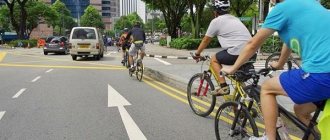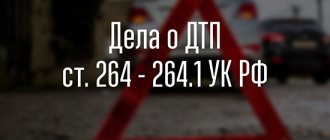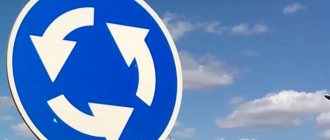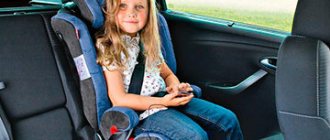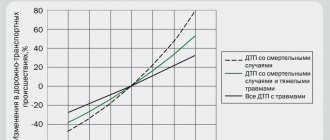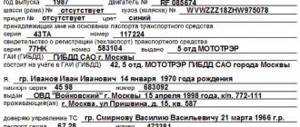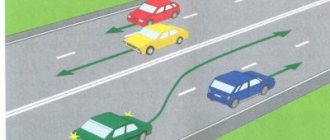Stop, car!
Traffic regulations clearly define the list of car faults with which you cannot drive. Clause 2.3.1:
“Driving is prohibited if there is a malfunction of the service brake system, steering, coupling device (as part of a road train), unlit (missing) headlights and tail lights in the dark or in conditions of insufficient visibility, the windshield wiper is inoperative on the driver’s side during rain or snowfall”
.
Other malfunctions - a smoking engine, a damaged windshield, a “cutting” exhaust - are not a reason to prohibit you from further driving.
“If other faults arise along the way, for which the appendix to the Basic Provisions prohibits the operation of vehicles, the driver must eliminate them, and if this is impossible, then he can proceed to the place of parking or repair, observing the necessary precautions.”
Tinting not in accordance with GOST, different and “bald” wheels, colored flashlights, etc. are a clear violation of the same paragraph 2.3.1:
“The driver is obliged to check before leaving and ensure the good technical condition of the vehicle on the way in accordance with the Basic Provisions for the admission of vehicles to operation and the responsibilities of officials to ensure road safety.”
It is clear that the tint itself could not stick to your car. You and she drove onto the road in violation of the Rules.
Road users are required to know and comply with the traffic regulations that apply to them.
Pedestrians and passengers who are road users are not required to know the traffic rules in full, like drivers. Some pedestrians may never read the Traffic Rules, but learn from childhood from rumors and the words of parents and teachers the requirements that apply to them, for example, that the road cannot be crossed in the wrong place or at a red light. However, ignorance of traffic rules does not exempt you from liability and fines. Therefore, the mere appearance of drivers, pedestrians and passengers on the road implies their familiarity with traffic rules and what normal behavior is expected of them.
If you intend to become a driver of a passenger car and obtain a driver’s license for the right to drive a category B vehicle, then it would seem that at the computer theoretical exam at the traffic police you should not be asked questions related specifically to motorcycles - category A or trucks, like This follows from what is declared in Section 1 of the Traffic Regulations.
For example, about the tread depth of tires for motorcycles and trucks, about the need to use a motorcycle helmet, because...
Such questions do not apply to car drivers, and they have no control over them. However, such questions may appear on the tickets - get ready to study the traffic rules in full, not just the topics that pertain to you personally, and practice to answer all exam questions correctly. Back to section
Drive on red
One of the most common violations is driving through a prohibiting (red) traffic light. However, the traffic rules have clause 13.7, which stipulates the following cases:
“A driver who enters an intersection when the traffic light signal permits must drive in the intended direction regardless of the traffic light signal at the exit from the intersection.”
.
However, this is only permissible if there is no stop line in front of the traffic light.
Prohibiting signals at a traffic light do not mean that you cannot exit the intersection under them. It is possible and necessary!
Prohibiting signals at a traffic light do not mean that you cannot exit the intersection under them. It is possible and necessary!
Turn according to the arrow
A common controversial situation on the road is turning at the arrow that allows a turn. If a traffic cop claims that this is a violation, it is a lie. Clause 6.3: “Traffic light signals, made in the form of arrows in red, yellow and green, have the same meaning as round signals of the corresponding color, but their effect applies only to the direction(s) indicated by the arrows. In this case, the arrow allowing a left turn also allows a U-turn, unless this is prohibited by the corresponding road sign.” In this case, you must remember clause 8.11: “Turning is prohibited:
- at pedestrian crossings;
- in tunnels;
- on bridges, overpasses, overpasses and under them;
- at railway crossings;
- in places where visibility of the road in at least one direction is less than 100 m;
- in places where route vehicles stop."
Turning under the left turn arrow is permitted. All exceptions are listed in the traffic rules.
Turning under the left turn arrow is permitted. All exceptions are listed in the traffic rules.
Accident
One of the most favorite “horror stories” for illiterate drivers is changing the position of vehicles on the roadway after an accident or leaving the scene of an accident. However, the traffic rules contain clause 6.1, which not only does not prohibit, but, on the contrary, prescribes such actions if only cars are damaged and they interfere with traffic:
“If, as a result of a traffic accident, damage is caused only to property, the driver involved in it is obliged to clear the roadway if the movement of other vehicles is obstructed, having previously recorded by any possible means, including by means of photography or video recording, the position of the vehicles along relation to each other and road infrastructure, traces and objects related to the incident, and damage to vehicles.”
The State Duma has tightened the punishment for leaving the scene of an accident - if the accident led to harm to health or death. If only the iron is dented, you can register without the traffic police.
The State Duma has tightened the punishment for leaving the scene of an accident - if the accident led to harm to health or death. If only the iron is dented, you can register without the traffic police.
Location of pedestrians on the road
Sidewalk
Pedestrians must move within the boundaries of sidewalks, if any. To achieve this, the rules provide for the complete clearing of sidewalks from kiosks and stalls if the permissible width is less due to their installation. The rules also stipulate the installation of enclosing structures at the edge of the sidewalk in the form of a curb, fence, etc.
This is done to prevent cars moving along the roadway from getting onto the sidewalk and causing harm to a pedestrian.
Roadside
If there is no sidewalk, you can also drive along the side of the road. In this case, you need to walk on the right side so that traffic flows towards the pedestrian.
Footpath
The boundaries of the pedestrian path are indicated by a separate road sign. Accordingly, the coverage area of this sign is limited only by the presence of a road for traffic. A person can feel calm on a pedestrian path, since cars are strictly prohibited from driving or parking on it. Only cyclists can travel on it, in addition to pedestrians.
Bike and pedestrian path
The marking of a bicycle and pedestrian path implies the movement of cyclists in the center and pedestrians on the sides. Not all pedestrians follow these rules. Such paths can often be seen in public places: parks, etc. They are designed for low speeds and rhythm of movement and delimit a place for walking between cycling enthusiasts and ordinary people.
Pedestrians in wheelchairs and carrying loads
When interfering with the movement of other pedestrians, this category of road users has every right to move along the roadway. Please note that this includes persons using a non-motorized wheelchair. In this case, no matter what the load, you are not forced to walk along the exact road along which the transport is moving, since this still increases the risk to your health.
We recommend:
Extreme car driving: training
Direction of traffic on the roadway
The main rule, in addition to being as close as possible to the side of the road, is to drive on the left side of the road towards moving vehicles. Exceptions include drivers of bicycles, motorcycles, mopeds and those using non-motorized wheelchairs. They must move along the road in the direction of traffic.
The driver is prohibited
Probably the most difficult traffic rule to perceive and remember, which everyone should still learn, but not for traffic cops, but for yourself - 2.7. This is a list of what is prohibited for the driver. The list is impressive:
“drive a vehicle while intoxicated (alcohol, drugs or other), under the influence of medications that impair reaction and attention, in a painful or tired state that jeopardizes traffic safety; transfer control of a vehicle to persons who are intoxicated, under the influence of medications, in a sick or tired state, as well as to persons who do not have a driver’s license to drive a vehicle of the appropriate category or subcategory, except for cases of driving training in accordance with section 21 Rules; cross organized (including foot) columns and take a place in them; consume alcoholic beverages, narcotic, psychotropic or other intoxicating substances after a traffic accident in which he is involved, or after the vehicle was stopped at the request of a police officer, before an examination to determine the state of intoxication or before a decision on release is made from carrying out such an examination;
The traffic rules state that the driver is prohibited from driving a vehicle while ill or under the influence of medications that impair reaction and attention.
The traffic rules state that the driver is prohibited from driving a vehicle while ill or under the influence of medications that impair reaction and attention.
drive a vehicle in violation of the work and rest regime established by the authorized federal executive body, and when carrying out international road transport - by international treaties of the Russian Federation; use while driving a telephone that is not equipped with a technical device that allows hands-free conversations. dangerous driving, expressed in the repeated performance of one or several consecutive actions, consisting of failure to comply with the requirement to give way to a vehicle using the right of way when changing lanes, changing lanes in heavy traffic when all lanes are occupied, except when turning left or right , turning, stopping or driving around an obstacle, failure to maintain a safe distance to the vehicle moving in front, failure to maintain a lateral interval, sudden braking, if such braking is not required to prevent a traffic accident, obstruction of overtaking, if these actions resulted in the driver creating a situation in the process of traffic , in which its movement and (or) the movement of other road users in the same direction and at the same speed creates a threat of death or injury to people, damage to vehicles, structures, cargo or other material damage.”
Obviously, this point is simply not familiar to many drivers or has been erased from memory. Worth a refresh.
10 traffic rules that a driver should know by heart
How to assess the safety of the road surface and avoid skidding
RussianSparrow/Fflickr.com
Let's say you are driving a modern car on the modern M4 Don toll motorway and have just passed a speed limit sign of 130 km/h. Be extremely careful if the temperature outside is below zero and there is drifting snow drifting across the asphalt. It means that the likelihood of the road becoming icy is high even if you see dry asphalt. Just slowly reduce your speed.
The same should be done when changing lanes when the lanes have been cleared and there is a small amount of snow between them. Slow down and change lanes without sudden movements or acceleration. Otherwise, skidding cannot be avoided.
Since we are talking about drifting snow and temperatures below zero, I want to warn you: beware of anti-icing agents that are sprinkled or watered on the road surface. This can play a cruel joke on you: a reagent designed for a temperature of -15 ° C will probably turn into oil if the temperature rises to zero the next day. And spikes on asphalt wet from such an oil reagent will only increase the likelihood of skidding and the length of the braking distance.
You should also be careful in the rain. Remember that on almost any road, if the asphalt was not laid yesterday, there will be at least a small rut. This is the most dangerous thing that can happen in the rain when changing lanes, as well as when driving in a lane.
Even at a speed of 90–100 km/h, when your car’s tire gets into this rut, the chance of finding out what hydroplaning is is very high.
A similar situation will occur on asphalt laid yesterday: water will be evenly distributed over its entire surface in the layer necessary for hydroplaning.
And here's another thing! Exchange rate stabilization and stability systems, traction control systems and ABS are unlikely to help in case of a sudden sharp skid at high speed. Accompanied by the cheerful crackling of these systems and the blinking of multi-colored lights on the dashboard, the car will cheerfully move towards the ditch, bumper or oncoming lane.


